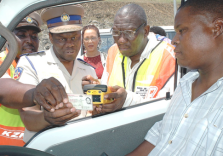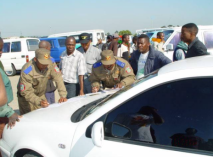|
KZN Easter Road Deaths - Lowest in Five YearsThe number of road deaths that occurred on KwaZulu-Natal’s roads this Easter was the lowest, when compared to the past five years.
In fact, had it not been for the bus crash near Hlabisa on 25 March 2005, which claimed the lives of ten people, the KwaZulu-Natal Department of Transport would have probably made history this Easter. This reduction in road deaths has been attributed to a number of factors, including the high level of visibility of our law enforcement officers, multi-disciplinary roadblocks, inter-provincial road blocks, 100% compliance, Omela eKhaya and so on. ENFORCEMENT STATISTICS
INTERPROVINCIAL MULTI-DISCIPLINARY ROAD BLOCKS The multi-disciplinary inter-provincial roadblocks held at Van Reenen's Pass and Umzimkhulu in conjunction with the Free State and Eastern Cape Provinces respectively, yielded excellent results. These inter-provincial operations sent a very strong message to the motoring public that we mean business, and will not tolerate bad road behaviour anywhere in the country. ADDITIONAL PATROL VEHICLES The deployment of nine additional patrol vehicles, courtesy of the National Department of Transport, along high accident frequency locations, did much to boost our road safety efforts and to increase our ability to deliver targeted law enforcement services. CARD VERIFICATION DEVICES (CVD’S) All nine vehicles mentioned earlier were fitted with CVD’s. This state of the art technology added tremendous clout to the improved data available to law enforcement officers at the roadside.
PEDESTRIANS Almost 90 pedestrians were arrested for walking on freeways. In this regard, problem areas still exist. More education programmes will be implemented. Also, more remedial engineering measures will be put in place to pedestrian proof national roads at certain high pedestrian problem areas. ROADSIDE COURTS Four roadside courts were in operation on the N3 at Cato Ridge and Bergville, and the N2 at Umdhloti and Park Rynie. Since 1 December 2004, more than 1 100 motorists appeared before the Magistrates at the various roadside courts. HIGHEST SPEEDING CONVICTION In what was probably the highest speed recorded in KZN in a decade, Mr. Johan Barkhuizen from Pretoria was arrested on 22 March after he was caught speeding at 275 km/h with a Kawasaki motorcycle on the N2 near Park Rynie. He appeared in the Scottburgh Magistrates Court and was fined R31 000. HIGHEST SPEEDS PER VEHICLE CATEGORY
FIXED SPEED CAMERAS Our investment in fixed speed cameras at certain high accident locations is definitely bearing fruit. At locations such as the N3 New England Road (Pietermaritzburg) a reduction of almost 90% in speeding offences has been recorded. We have also seen a similar reduction at other locations such as the N2 near the Cement Plant at Queensburgh. PUBLIC TRANSPORT ENFORCEMENT UNIT (PTEU)
CONCLUSION We want to also express our thanks and appreciation to all members of the public who have assisted us by obeying all road rules, and thereby contributing to the successes that we have achieved. Let us continue resolutely in our efforts to save lives.
|

 Officers
from our PTEU were deployed along routes frequently travelled by public
transport vehicles, such as the N3 and the R617 Boston/Bulwer route. Roads
travelled by buses and taxis conveying mainly migrant workers to and from
Gauteng and other provinces were also targeted. 20 Buses and 92
taxis were suspended for being in an un-roadworthy condition. A further 222
drivers of public transport vehicles were arrested for not being in possession
of the necessary route permits.
Officers
from our PTEU were deployed along routes frequently travelled by public
transport vehicles, such as the N3 and the R617 Boston/Bulwer route. Roads
travelled by buses and taxis conveying mainly migrant workers to and from
Gauteng and other provinces were also targeted. 20 Buses and 92
taxis were suspended for being in an un-roadworthy condition. A further 222
drivers of public transport vehicles were arrested for not being in possession
of the necessary route permits.